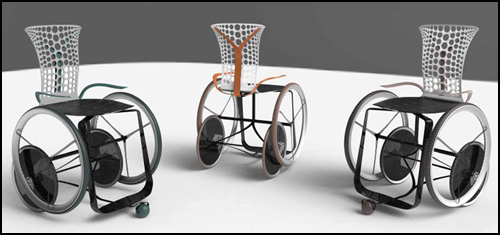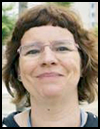 The Phase Change Matters e-mail newsletter is a weekly summary of the latest news and research on phase change materials and thermal energy storage. To subscribe, visit www.puretemp.com/subscribe. For more frequent updates, follow @puretemp on Twitter or visit the Phase Change Matters blog, www.puretemp.com/pcmatters.
The Phase Change Matters e-mail newsletter is a weekly summary of the latest news and research on phase change materials and thermal energy storage. To subscribe, visit www.puretemp.com/subscribe. For more frequent updates, follow @puretemp on Twitter or visit the Phase Change Matters blog, www.puretemp.com/pcmatters.
AWARDS
Design student’s innovative wheelchair concept wins U.K. competition

A student’s creative take on wheelchair design has won a national competition in the United Kingdom.
Kristen Tapping, a product design student at London South Bank University, won the inaugural “Getting Back on Track” design competition held by the law firm Bolt Burdon Kemp. The contest challenged UK-based university students to design a product aimed at improving the lives of people with a spinal cord injury. The law firm awarded Tapping £3000; the university awarded an additional £2,000 (a total of about $6,500).
Tapping’s lightweight wheelchair features a seating material enhanced with phase change material to ensure thermal comfort and a split wheel-to-rail system that eases movement through gear reduction and wider pushing surfaces. Tapping provided details on the concept in an email interview.
Q: How did you become interested in product design?
A: “I had worked a wide array of jobs from bartender to personal trainer to TV salesperson and decided a decade after getting my first degree to get into design, something I had always been interested in but wasn’t sure I would be good at. I studied a year of interior design but stopped as I felt it was too limited for what I wanted. When I came across industrial/product design, the combination of conceptual design with hands-on prototyping was a perfect fit and I dived right in. I am currently on placement in Spain designing automotive interiors for Grupo Antolin.”
Q: Moveo’s most ingenious feature appears be the propulsion system. Reverse propulsion is used in at least one wheelchair on the market (https://www.rowheels.com/product), but your concept separates the hand wheel from the ground wheel, using a spur gear to maximize force. What inspired you to pursue this approach? Is this configuration unique, as far as wheelchairs?
 A: “This design challenge was specialized for people with spinal cord injuries which are quite different from others – on top of not being able to walk, many cases affect the upper body nerves leading to the inability to have dexterity and strength in the hands. With this in mind, it is exponentially harder for them to push a wheelchair rail as they cannot grab it. The other issue I noticed with all wheelchairs (that I have seen so far at least) is that the user touches the wheel when pushing the rail – I tested this myself by sitting in one and I could not push forward without coming into contact with the wheel. This is obviously not very pleasant or sanitary – would be the equivalent of a non-wheelchair user touching their hand to the base of their shoe after each step.
A: “This design challenge was specialized for people with spinal cord injuries which are quite different from others – on top of not being able to walk, many cases affect the upper body nerves leading to the inability to have dexterity and strength in the hands. With this in mind, it is exponentially harder for them to push a wheelchair rail as they cannot grab it. The other issue I noticed with all wheelchairs (that I have seen so far at least) is that the user touches the wheel when pushing the rail – I tested this myself by sitting in one and I could not push forward without coming into contact with the wheel. This is obviously not very pleasant or sanitary – would be the equivalent of a non-wheelchair user touching their hand to the base of their shoe after each step.
“The design started with the necessity for the wheel to be separate from the rail to avoid touching the wheel and give users a wider pushing surface in a material that has more inherent grip than metal (here I proposed Infinergy, a BASF/Adidas material that is made from recycled Adidas shoes). After consulting with some engineers, I made this happen through a simple spur gear mechanism where pushing the rail backwards would push the spur gear which would in turn propel the wheel forward. The pushing backwards to move forward simply came about from this spur gear mechanism, however it could be switched back to pushing forward to move forward by simply adding an additional gear. Ideally, the user would be able to manually switch back and forth between pushing forward and backwards to prevent muscle fatigue.
“As far as I know my configuration is unique in wheelchairs – I have only seen the rail being at the side of the wheel as in the standard design. As far as other products go, it follows a bicycle’s basic spur gear mechanism.”
Q: How did you become familiar with phase change material? Have you used it in other projects?
A: “I came across PCMs while interning at a materials firm and became really fascinated with the process they continually undergo. The reason I used them in this concept is because a less known side-effect of spinal cord injuries is the inability to self-control body temperature – the user’s body may be extremely hot when it is cold out, and visa versa. I felt that using a PCM fabric on the seat would help bring down the overall body temperature to a more stable point. I have not used PCMs prior to this project however I am using it in a current concept regarding heat recovery. I am really interested to see where the technology will go – for example the recent university study that managed to activate PCM heat release with a light trigger.”
Q: Can you provide details on the PCM fabric used in your design (salt hydrate/biobased/paraffin; peak melt point; energy storage capacity in joules per gram; manufacturer, etc.)?
A: “The fabric I proposed was Schoeller PCM 30092, which has a thermal storage capacity of 35,000 joules per square meter. Schoeller provides a variety of thicknesses which affect the energy storage capacity and padding/comfort level. While specifying a certain fabric would require prototyping and testing, I would suggest one with a composition of 37% polyurethane, 36% polyester and 27% paraffin.”
Q: The energy storage capacity of PCM-coated fabric is much less than PCM encapsulated in flexible film. Did you consider using PCM cooling packs instead of PCM fabric?
A: “This option could be explored to see which would work best in this product. One benefit of the PCM-coated fabric is the ability to place it in the washer, something I had in mind for Moveo.”
Q: What’s next for the Moveo: patent application, prototypes, commercial development, etc.? Have any manufacturers expressed a commercial interest?
A: “While I doubt a patent application would be valid since this was a student competition and the details have already been made public through various publications, I would rather the concept be an inspiration to other wheelchair designers to address the wheel/rail issues stated above. Entering this competition, I wanted to design anything else than a wheelchair, but after being frustrated seeing horrible designs and how they affect the users’ daily lives, I decided to give it a go. I did see an interesting student competition entry that uses handles and gears to move forward, but otherwise am disappointed with the lack of innovation from established manufacturers to solve the issue of users having to touch the wheel every time they push.
“I am currently on placement so sadly have no time at the moment to prototype it, however I may make it my final year project once back at LSBU. It would be great to partner with Cerebra [a research center] to possibly make Moveo a real product. However a wheelchair needs lots of engineering and testing so partnering with an experienced manufacturer as well would make a great team.”
Q: Any idea what you’d like to focus on after graduation?
A: “Really not sure. I am as excited designing a futuristic car interior than I am an ergonomic toilet brush – I just really love design. One thing I do know is I want to design useful products that have a positive impact on people’s everyday lives and do not degrade the environment during usage and at end of product life. With this project and having just won the Heatrae Sadia competition (hot water cylinders), I find myself being more and more interested in smart insulation and thermal storage solutions that work sustainably with zero or little energy. With our planet’s diminishing resources and increasing temperature, solutions in this field will definitely be a necessity.”
GOVERNMENT
10 BioPCM products added to USDA BioPreferred catalog
Phase Change Energy Solutions has joined PureTemp and Croda International in the U.S. Department of Agriculture‘s BioPreferred catalog. The North Carolina manufacturer has registered 10 of its phase change materials in the program: BioPCM Q4, Q6, Q8, Q15, Q18, Q20, Q23, Q25, Q27 and Q29.
The USDA defines biobased products as finished or intermediate materials composed in whole or in significant part of agricultural, forestry or marine ingredients. The program’s purpose is to increase the purchase and use of biobased products. Products that meet the USDA BioPreferred program requirements carry a distinctive label for easier identification by the consumer.
 “BioPCM is now certified with 100% biobased content and listed among the USDA BioPreferred products, demonstrating our commitment to sustainability as we work to meaningfully reduce energy consumption,” said Dr. Reyad Sawafta, chief scientific officer at Phase Change Energy Solutions.
“BioPCM is now certified with 100% biobased content and listed among the USDA BioPreferred products, demonstrating our commitment to sustainability as we work to meaningfully reduce energy consumption,” said Dr. Reyad Sawafta, chief scientific officer at Phase Change Energy Solutions.
Seven CrodaTherm products qualified for the program in 2016. PureTemp first qualified in 2014, and 23 PureTemp formulations are now designated as 100 percent biobased by the program.
Phase change material is not currently one of the 109 categories in the USDA’s BioPreferred Program. Phase Change Energy Solutions, Croda and PureTemp products became certified through a voluntary labeling initiative. The USDA published a proposal last week to add PCMs as a category of biobased products eligible for procurement preference by federal agencies and their contractors. Public comments on the proposed rule changes will be accepted until Nov. 13.
PATENTS
Low remnant free microcapsules and method of making same
U.S. patent application 20180273820 (applicant Microtek Laboratories Inc., Dayton, Ohio)
“A microcapsule or microcapsule having a polymer wall comprising a melamine formaldehyde reacted with a crosslinking agent to form a unit cell according to a general formula (II) and/or the polymer wall has a FT-IR Spectrum as shown in FIG. 4. The crosslinking agent is a mixture of a reaction product of a cyclic urea (U) and a multifunctional aldehyde (A), and at least one crosslinker selected from the following group: a reaction products of (i) an aminotriazine and at least one aldehyde selected from the group consisting of aliphatic monoaldehydes and multifunctional aliphatic aldehydes, (ii) urea and/or cyclic ureas and formaldehyde, or (iii) phenols and aliphatic monoaldehydes, or from alkoxycarbonylaminotriazines, or multifunctional isocyanates, epoxides, aziridines, and carbodiimides.”
Thermal energy storage phase change materials comprising triamines
U.S. patent application 20180273819 (applicant Entropy Solutions LLC, Plymouth, Minn.)
“This invention generally relates to phase change materials, thermoregulation, thermal protection and insulation. In particular, in alternative embodiments, provided are organic Phase Change Materials having different chemical moieties including triamines, nitriles, anhydrides and/or benzoic acid and combinations thereof. … In alternative embodiments, the Phase Change Material (PCMs) compositions and products of manufacture are used for thermal energy management and temperature stabilization in various applications such as building and insulation materials, automotive, airline, weapons systems, computers and electronics, clothing, packaging, cookware, garment and footwear, pharmaceuticals and drug storage systems, and other food and energy storage and temperature stabilization systems.”
Thermal interface composite material
U.S. patent application 20180277910 (applicant Regents of the University of California, Oakland, Calif.):
“A composite thermal interface material and methods are shown. Devices such as lithium ion batteries incorporating composite thermal interface materials show significant improvement in cooling performance. In one example, composite thermal interface materials shown provide cooling through both a phase change mechanism, and a heat conducting mechanism which directs heat away from the device to be cooled, such as electrochemical cells in a battery, to an external housing and/or a coupled heat exchange device such as radiating fins.”
IN BRIEF
 • The enrollment period is open for an online master’s degree program on thermal energy storage. The program, offered by the University of Lleida and the University of Barcelona, includes “training in technical aspects of TES and the energy system, but it also includes soft skills in patenting and entrepreneurship.” The program is directed by Dr. Luisa F. Cabeza, right, of the University of Lleida.
• The enrollment period is open for an online master’s degree program on thermal energy storage. The program, offered by the University of Lleida and the University of Barcelona, includes “training in technical aspects of TES and the energy system, but it also includes soft skills in patenting and entrepreneurship.” The program is directed by Dr. Luisa F. Cabeza, right, of the University of Lleida.
• Siemens Gamesa held a topping-out ceremony this week for its 30MWh electric thermal energy storage facility in Hamburg-Altenwerder, Germany. The pilot facility, which stores energy in 1,000 tons of rock fill at temperatures of 600º C, is in its final phase of construction and due to be fully commissioned in 2019.
• Lauren Boteler, a thermal/packaging engineer for the U.S. Army Research Laboratory’s Sensors and Electron Devices Directorate, has been named Woman Engineer of the Year by the American Society of Mechanical Engineers’ Electronics Packaging and Photonics Division.
• Indonesia has imposed a three-year moratorium on new palm oil plantations and ordered a review of existing ones in an effort to address sustainability and environmental concerns.
• The U.S. patent system, the first in the world to incentivize large numbers of ordinary citizens to innovate, has long been ranked No. 1 in the world. But over the past few years the system has fallen to 12th. Forbes reports that Andrei Iancu, the new director of the U.S. Patent and Trademark Office, is working to turn that around and “bring about a much-needed revitalization of the American patent system.”
• Alexium International has appointed Jason Lewis as chief financial officer, succeeding Aaron Krech, who resigned effective Sept. 30. Lewis has over 20 years of experience in financial roles in the specialty chemicals industry. Alexium also announced the appointment of Allen Reihman as chief commercial officer. He will lead the company’s sales, marketing and technology commercialization efforts. Alexium, based in Greer, S.C., and Perth, Australia, makes flame-retardant and PCM-enhanced fabric treatments.
RESEARCH ROUNDUP
For our full list of recent academic research, see puretemp.com/academic. Here are highlights from the past week:
From Applied Energy:• Microencapsulation and thermal properties of myristic acid with ethyl cellulose shell for thermal energy storage
• Fast and experimentally validated model of a latent thermal energy storage device for system level simulations
• Numerical simulation and experimental validation of the solar photovoltaic/thermal system with phase change material
• Low-temperature energy conversion using a phase-change acoustic heat engine
From Journal of Energy Storage:
• Exploring additives for improving the reliability of zinc nitrate hexahydrate as a phase change material (PCM)
From Energy:
• Laboratory assessment of residential building walls containing pipe-encapsulated phase change materials for thermal management
• Review on thermal performances and applications of thermal energy storage systems with inorganic phase change materials
From Nano Energy:
• Nanoconfinement effects on thermal properties of nanoporous shape-stabilized composite PCMs: A review
From International Journal of Thermal Sciences:
• Study of heat and fluid flow during melting of PCM inside vertical cylindrical tube
From Building and Environment:
• A new hybrid personal cooling system (HPCS) incorporating insulation pads for thermal comfort management: Experimental validation and parametric study
From International Journal of Heat and Mass Transfer:
• An analytical technique for the optimal designs of tube-in-tank thermal energy storage systems using PCM
From 2nd International conference on Advances in Mechanical Engineering:
• Study of freezing characteristics of water based grapheme Nano-fluid PCM in a spherical capsule [pdf]
• Enhancement of thermal conductivity of PCM using filler graphite powder materials [pdf]
From 10th International Conference on Applied Energy:
• A Numerical Investigation into the Heat Transfer and Melting Process of Lauric Acid in a Rectangular Enclosure with Three Values of Wall Heat Flux
NETWORKING
Connect with PCM experts and industry leaders on LinkedIn
 More than 1,350 people have joined a LinkedIn group devoted to the discussion of phase change material and thermal energy storage. The Phase Change Matters group is an interactive complement to the award-winning blog and newsletter of the same name.
More than 1,350 people have joined a LinkedIn group devoted to the discussion of phase change material and thermal energy storage. The Phase Change Matters group is an interactive complement to the award-winning blog and newsletter of the same name.
You are invited to join the group and connect with PCM and TES experts from around the world. This week we welcome Mauro Papagni, CEO at e-4e Srl, Aosta, Italy: Vivek Gupta, data analyst, Jalandhar, India; David Haan, marketing manager, Microtek Laboratories Inc., Dayton, Ohio; and Shridhar Ramani, associate application engineer at Pluss Advanced Technologies, Rewari, India.